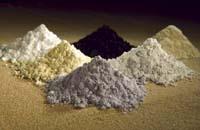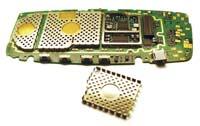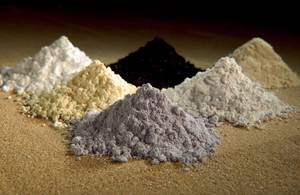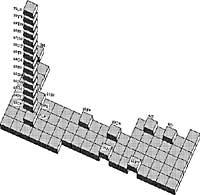Rare metals in the process of exhaustion?
2009/12/01 Galarraga Aiestaran, Ana - Elhuyar Zientzia Iturria: Elhuyar aldizkaria

Electric and hybrid cars, plasma TV screens, catalysts, LCD panels, computer hardware, charging batteries, magnetic resonance devices, turbines of wind turbines… all contain metals or rare lands among their components. Furthermore, rare lands are essential components of these products.
They are, therefore, the typical ingredients of traditional products, and are increasingly used in the industry. In fact, last year 126,682 tons of rare metals were consumed in the world and this year it is expected to reach 113,610 tons. For 2014, the market research company BCC Research foresees a figure of 175,618.
Its concentration on the terrestrial surface is not very rare. The most abundant is the cerio, with a concentration of 60 ppm, while the least is the tulio and the lutetium, with about 0.5 ppm. In other words, they are more concentrated than silver on the terrestrial surface and the four more abundant (Lantano, Cerio and Neodymium), more than lead. The sum of all of them represents a quarter of non-ferrous metals.
However, it is very difficult to find suitable locations for commercial extraction of rare metals. The minerals containing more rare metals are the bastnasita, the monacite, the loparite and the xenotima, very dispersed on the terrestrial surface.
Until the 1980s, the U.S. Mountain Pass mine was the main source of rare land. The extracted stick contains 50% cerium, 34% lanthanum, 11% neodymium and 4% praseodymium, and some samarium, gadolinium and europio.

At that time, however, in China was found an immense mineral of bastnasita, Bayan Obon, which is estimated at 36 million tons of mineral. Since then, the Bayan Obo mine has become the world's leading source of rare metals. In addition, in China there are clays that have absorbed the rare earth ions, which are in surface, so extraction is simple and profitable. Thus, China has taken control of the market: more than 95% of rare metals marketed last year had Chinese origin.
Market law
In addition to mining, processing of minerals and the extraction and separation of rare metals, Chinese companies predominate. Thus, at present, about 35,000 people work in the production of rare metals in China and 15,000 graduates in new products manufactured with these metals.
After China, the United States is the leading producer of rare metals. The mineral is purchased concentrated in China, from which rare metals are extracted to produce the necessary alloys. Other countries with some relevance in the rare metals market are Australia, France, Japan and Canada. Anyway, in no case can they be equated with China.
In addition to the supplier of rare metals, China is also a user, as 60% of those used in the world were consumed there. In Japan and southeast Asia, 24% were consumed, while in the United States consumption was 10%.
The total superiority of China provokes nervousness in many experts and stakeholders. Between 2007 and 2008 the price of rare metals increased between 20% and 40%, mainly due to the increase in supply and limitation of supply in China. For example, the price of lanthanum oxide used in NiMH batteries increased by 15% and a ton cost $5,000 in early 2008. In addition, they expect to continue increasing the demand for batteries for hybrid cars.

Basics in the Future
In fact, the hybrid metal industry has been developed thanks to hybrid metals. In fact, the development of hybrid cars is due to the need to reduce greenhouse gases, but this development would not be possible without the proper components. Although a hybrid car contains only about 15 kilos of rare metals, they are essential in NiMH batteries, electric motors, regenerative braking systems and catalysts.
Something similar occurs in electronic and audiovisual products, telecommunications and computer tools. Computer technology, for example, is based on rare metal magnets. They are used in hard disks, DVDs and CD-ROMs that allow to store more and more information in an increasingly reduced space.
The U.S. Geology Section also gives great importance to rare lands. Annually, it compiles a report on the minerals in which, in addition to those cited, other aspects in which a growth of rare metal applications is expected. Specifically, fiber optics and medical applications are included, namely “dental and surgical lasers, magnetic resonance devices, contrast agents and medical isotopes”. Rare metals will also serve to further develop nuclear energy, according to the report's authors.
In addition, the US Geology Section provides for an increase in demand as developing countries are industrialized. For the moment, the quantity that China markets is sufficient to cover the demand, since it is currently consumed between 50 and 75% of the production, according to the article published by the physicist Nauvov in Russian Journal of Non-Ferrous Metals

However, to ensure that in the future they will have no problems with the supply of rare metals, companies in the United States, Australia, France, Canada, Japan and Russia are establishing alliances with Chinese companies. In addition, efforts are being made to find new mines in places like India or Canada.
The darkest example of what can happen in competition for rare lands is the war of the Democratic Republic of Congo. This country is the main producer of the mineral called coltan. The coltan tantalum is extracted and the tantalum is key in mobile and many other electronic devices, as it is an indispensable component of electrolytic capacitors. Thus, the United Nations Organization itself establishes a direct relationship between the war in the country and the desire to control the coltan mines.
While the most pessimistic announce a demanding future, market experts and analysts advise investing in innovation to anticipate rare metal scarcity problems. Two ways are proposed: on the one hand, to investigate how to make the recycling of these elements profitable, and on the other, to look for alternatives to rare metals, more abundant than them and better distributed in surface.

Gai honi buruzko eduki gehiago
Elhuyarrek garatutako teknologia






